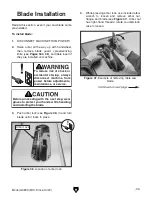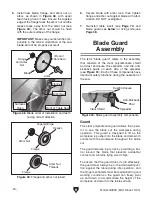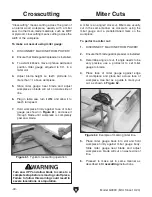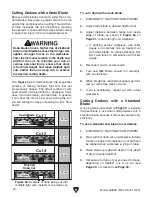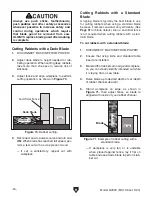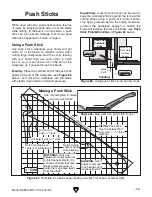
Model G0899 (Mfd. Since 10/20)
-43-
Commonly used in furniture joinery, a rabbet is an
L-shaped groove cut in the edge of the workpiece.
Rabbets can be cut with either a dado blade or a
standard saw blade.
Rabbet cutting on the edge of the workpiece
with a dado blade requires a sacrificial fence
(see
Figure 69). Make the sacrificial fence the
same length as the fence and
3
⁄
4
" thick. Attach it
to the fence with screws or clamps, making sure
they are all secure and tight. Raise the blade into
the sacrificial fence to the height needed.
Rip Fence
Sacrificial
Fence
Dado Insert
Blade Cut-Out
Figure 69. Example of sacrificial fence.
Rabbet Cutting
6. Reconnect saw to power source and turn saw
ON. Allow blade to reach full speed, then per-
form cutting operation.
7. Repeat cutting operation on other side of
dado, as shown in
Figure 67.
8. Make additional cuts (see Figure 68) in cen-
ter of dado to clear out necessary material.
Dado is complete when channel is complete-
ly cleared out.
Workpiece
Fence
Cut 2
Blade
Figure 67. Second cut for a single-blade dado.
Workpiece
Fence
Cuts 3+
Figure 68. Additional single-blade dado cuts.
Blade
Workpiece
Fence
Cut 1
Figure 66. First cut for a single-blade dado.
5. Align blade to cut one side of dado, as shown
in
Figure 66.
Dado blades have a higher risk of kickback
than normal blades because their larger size
applies stronger forces to the workpiece.
This risk increases relative to the depth and
width of the cut. To minimize your risk of
serious personal injury, ensure that stock
is flat and straight, and make multiple light
cuts (rather than one deep cut) to achieve
the desired cutting depth.
When using a dado blade, the included dado
table insert must be installed and used during rab-
beting operations.
Summary of Contents for G0899
Page 92: ......





